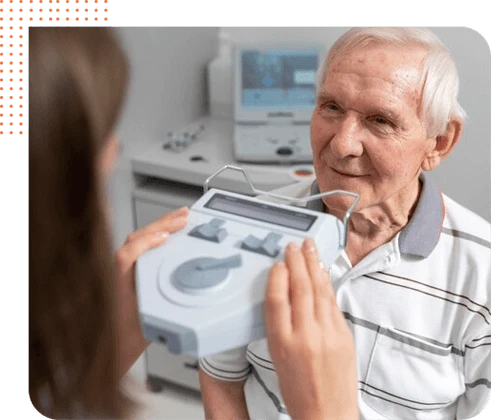Ocular Ultrasound
Eyes on Brickell is Miami’s premier eye care clinic, offering personalized solutions and cutting-edge technology to support exceptional vision health. Our skilled optometrists, led by Dr. Antoine, utilize advanced diagnostic tools like ocular ultrasound to ensure accurate detection of eye conditions.
We perform A-Scan ocular ultrasounds to measure your eye for proper intraocular lens fittings before cataract surgery. B-Scan ocular ultrasounds thoroughly evaluate the posterior of your eye to aid in early diagnosis. Along with comprehensive exams and vision correction options, our commitment to compassionate patient care makes Eyes on Brickell the trusted choice for your ophthalmic needs. Let our team support your eye wellness with innovative assessments tailored to your needs.

What is Ocular Ultrasound?
It is a non-invasive imaging technique to visualize the structures both inside the eye as well as through direct contact with the eye by using high-frequency sound waves. This eye ultrasound scan is used to detect diabetic retinopathy problems such as vitreous traction, retinal detachment, and blood behind the retina. At Eyes on Brickell, we specialize in providing precise ocular ultrasound services, ensuring accurate detection of these issues.
Contact us for Ocular ultrasound in Miami today!
It's Types
- A-Scan:
The A-scan checks your eye length to help pick the right lens for cataract surgery. You either sit with a probe against your eye or lie down with a water bath touching it. - B-Scan:
The Ocular Ultrasound B-scan looks at the space behind your eye, which is helpful when things like cataracts make it hard to see. You close your eyes, a gel goes on your eyelids, and you move your eyes around while a gentle ultrasound probe is placed on your eyelids.As a leading optical clinic in Brickell, we offer both A-Scan and B-Scan services. Whether you need precise measurements for cataract surgery (A-Scan) or a detailed view behind your eye (B-Scan), our eye doctors ensure a comfortable and thorough experience to support your eye health.
Its Benefits
- Comprehensive Insight: With it, you can get a thorough understanding of eye health in just one scan.
- Timely Issue Recognition: It helps eye doctors in the early detection of potential eye concerns, enabling informed decisions and proactive interventions.
- No Radiation Exposure: It doesn’t involve ionizing radiation, minimizing potential risks associated with repeated exposure, which is especially important for pregnant patients or those who need frequent monitoring.
- Patient Comfort: Generally well-tolerated by patients, causing minimal discomfort during the procedure.
- Cost-Effective: Compared to some other imaging modalities, this technique tends to be more cost-effective, making it a viable option for medical facilities with budget constraints.
What Happens During Ocular Ultrasound?
It is an effective process with minimal risks and side effects. But before proceeding further with the scan, you might wonder about the process and how it will be done.
Let’s have a close look at the steps involved in it, ensuring you feel at ease and informed about the entire process.
Here’s the simple process that we follow at our optical clinic in Miami:
- To ensure your comfort, we’ll use gentle anesthetic drops to numb your eye—making the procedure quick and painless. Don’t worry as your pupils won’t be dilated, though your vision may be temporarily blurry during the test.
- A specialized probe will be carefully placed over your eye.
- You might be asked to move your eye back and forth a bit. It’s a simple step to capture comprehensive images and gather the necessary information.
- The entire process typically takes just around 15 minutes. It’s a brief commitment for valuable insights into your eye health.
- Good news—there’s no need for prolonged waiting. As soon as the test is complete, the results are readily available for discussion.
Is There Any Risk Associated with Ocular Ultrasound?
It is generally considered safe with minimal risks. It is a non-invasive imaging technique utilizing sound waves to visualize internal eye structures. The procedure is painless, and the ultrasound technology employed poses little risk as it doesn’t involve ionizing radiation. Potential risks are rare and may include mild discomfort or irritation from the ultrasound gel.
Additionally, individuals with certain eye conditions or infections may require caution. However, problems after ocular ultrasound are rare, and the good part is getting the right diagnosis quickly is usually more important than any small risks.
So, it is suggested to consult with our eye doctor, Dr. Antoine Copty before considering any eye care service.



